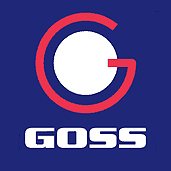The Pacesetter’s complex history goes back a long way. The original saddlestitchers were designed by Sheridan in the 1950s and sold to Harris Corporation in the 1970s. Heidelberg bought the Harris web press division in 1986 and the bindery division in 1992, when it revamped the 8,000, 10,000 and 12,000cph saddlestitchers into its new ST range. The remaining stitchers, which ran at 15,000cph and above, were not revamped. “Why change a winning machine,” asked then-Heidelberg UK bindery specialist Chris Fewings. But when, in 2004, Goss purchased Heidelberg’s web press division – together with the newspaper inserting and mailroom kit, the Universal perfect binders and the higher-capacity saddlestitchers – the new owners took a different view. Putting saddlestitcher R&D at the top of the corporate agenda, in mid-2005 Goss signed a deal with Ferag to cover the North American market.
Joining forces
“We wanted a stitcher we could run at 25,000cph,” says Goss vice-president for print finishing Toby Clarke. “Our engineers were telling me we had the feeders, the stitcher and the delivery, but we didn’t have the trimmer. So I called Ferag and we agreed their SNT drum was what we needed.”
The two teams of engineers hooked an SNT onto the Pacesetter . A prototype model was installed at a heatset web plant in Minnesota last year and “has worked beautifully ever since”, according to Clarke. As has the joint venture itself: the new Pacesetter + Ferag nudges the Goss post-press range into a bracket where it can cope with the output from the average commercial heatset web, thereby complementing the Goss press portfolio. It also provides Ferag with a lower-capacity stitcher to extend the reaches of its post-
press range.
The Pacesetter + Ferag follows a linear architecture, where the gatherer hoppers feed onto a saddle chain running underneath the hoppers. In this, it differs from some rival stitchers, which take gathered books through a 90° turn before they reach the stitching unit. The linear architecture not only contributes to the speed, but extends the opportunities for inkjetting. Where a non-linear feeder offers inkjetting opportunities in directions parallel to the spine, a linear feeder can also inkjet in the read-write direction, at right-angles to the spine. In an increasingly selective environment for mailing, Clarke identifies this as “a big opportunity – you can do a unique message on every book in places where you haven’t been able to reach before”.
Variation and flexibility
The Pacesetter + Ferag’s feeders are servo-driven and of universal design. This means, a single feed mechanism can handle a wide range of signatures, including gatefolds, reverse lap and the infamous 96pp section. Feeders can be swapped out easily – they just slide off the base frame onto a mobile cart – and any unit can be replaced with sample-gluers (made by fellow US company Clever) for tip-on work. The only variation on the standard feeder is the folder-feeder. If a job comes with pre-folded covers, these run through a standard feeder, but if the covers are supplied flat, the Pacesetter has a pre-scoring, folding cover feeder that follows the same design as the standard feeder, so the cover feeder can be positioned anywhere on the line.
A maximum of 40 feeders can be installed, in increments of two, and the hoppers can be loaded by hand, by an automated hopper loader or from roll, all on-the-run. Goss has also introduced the concept of ‘zero makeready’, based around the feeders’ servo-drives. Clarke explains: “If you’ve got an eight-unit gatherer and you’re using four feeders to run a job, you can make the four unused feeders ready for the next job while the first one is running.”
Running at 25,000cph (the Pacesetter + Ferag’s rated top speed) calls for a dual stitching unit, where each unit stitches alternate signatures, with up to six stitching heads delivering up to three stitches per book. A Pacesetter + Ferag specified with a single stitching unit runs at 22,000cph, with up to four heads putting in four stitches per book. The mechanism is a flying stitch: the book is kept moving, although slowed down, while the stitching is done.
The maximum book size handled by the Pacesetter + Ferag is an A4 spine length and Clarke says it’s unlikely that customers will want to make two-up streams out of such a small cut-off. However, for those customers who do, the SNT trimmer can be supplemented by an inline slug-cutter, which supplies the fourth and fifth knives necessary for two-up work. As for delivery, the full Ferag range of stackers, conveyors, pressing stackers, bundlers and strappers is available.
Automated makeready
Makeready is, as might be expected, highly automated (although the Pacesetter + Ferag isn’t JDF-enabled). Basic job dimensions are programmed into the controller and the line automatically positions the chain relative to the feeders, stitchers, trimmer and delivery. However, the feeder adjustment hasn’t been automated. “It can be done just as fast and much more effectively, on the hoppers, on the run. Operators like it better,” says Clarke.
Having been sidelined in Europe by former owners Heidelberg, Goss has taken some careful pains to ensure the new Pacesetter + Ferag is “a truly European saddlestitcher”, according to Clarke. Most important, the Pacesetter + Ferag handles a full-format A4 product for long cut-off signatures and the feeders can take a 96pp signature, despite the fact such a signature is unheard-of in the US market where low paginations rule. Additionally, two German engineers were retained from Heidelberg to bring continuity to the Pacesetter + Ferag’s design and the revamped machine uses Siemens electronics for ready European availability of spare componentry. Goss has even paid attention, quite literally, to the nuts and bolts: they’re all metric, despite the fact production of the Pacesetter + Ferag is based in the US.
But the Pacesetter + Ferag does take at least one useful lead from its US heritage. The new saddlestitcher can be driven by a distribution list fed into its central controller to selectively bind and track each unique book through to the delivery. There’s also an automatic re-order facility, where a spoiled book is rejected and immediately gathered and stitched again. However, as Clarke points out, such an approach to selective binding depends on good discipline in the bindery: “If an operator loads the wrong signature into hopper one, the machine has no way of knowing it’s wrong.” So the Pacesetter + Ferag optionally offers signature recognition by barcode or image recognition.
Goss is careful to stipulate that the Pacesetter + Ferag, while designed to handle long runs, is also well-suited to shorter runs: the current test sites are running jobs of between 2,000 and 2m copies. There are already 15 orders on the Goss books, mainly from the US, but with some from Europe. “We’re very excited to be launching this machine,” Clarke says. “We’re going to make a name for ourselves.”
SPECIFICATIONS
Max book size 241x320mm
Min book size 127x206mm
Max book spine thickness 10mm
Top speed 25,000 copies per hour
Price £1.1m – £1.97m depending on specification
Contact Goss International 01772 257571 www.gossinternational.com
THE ALTERNATIVES
Muller Martini Tempo 22
Muller’s Tempo is one of two stitchers in a head-to-head bracket with the Pacesetter + Ferag. It’s a bit slower and is semi-automated, meaning that it’s got Muller’s Automation Platform for one-touch size-setting and is JDF-compatible for operating data collection. Feeders are continuous flat-pile models or vertical stack feeders and there’s a sample gluer and folder feeder, all up to 40 stations. There are up to four stitching heads and a choice of models, giving alternate chain pitches and stitching thicknesses. The maximums in the range are shown below.
Max book size 340x260mm
Min book size 210x155mm
Max book spine thickness 6mm
Top speed 22,500 copies per hour
Price from £600,000
Contact Muller Martini 0845 345 3588 www.mullermartini.com
Muller Martini Supra
Until now, the Supra has enjoyed the high ground of saddlestitching unchallenged. It is very similar in its specifications to the Pacesetter +Ferag, with a double stitching unit as standard. In a standard 1:1 loading mode, it runs at 25,000cph, but bumps up to 30,000cph with 2:1 preloading devices attached (stream feeders or rolls). It also has up to 30 feeders, which should still be plenty for the European market, and uses Muller’s new, super-fast crank trimmer for single-up production only.
Max book size 340x260mm
Min book size 210x155mm
Max book spine thickness 6mm
Top speed 30,000 copies per hour
Price from £2m
Contact details as above
Read the original article at www.printweek.com.
Comment below to have your say on this story.
If you have a news story or tip-off, get in touch at editorial@sprinter.com.au.
Sign up to the Sprinter newsletter


